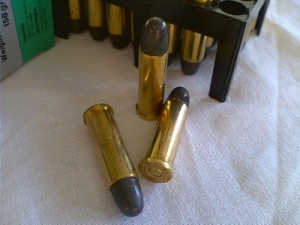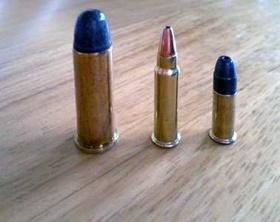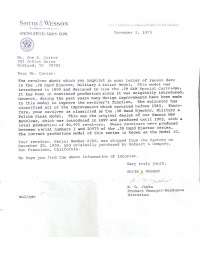.38 Special
| .38 Special | |||||||||||||||||||
|---|---|---|---|---|---|---|---|---|---|---|---|---|---|---|---|---|---|---|---|

| |||||||||||||||||||
| .38 Special rounds | |||||||||||||||||||
| Type | Revolver | ||||||||||||||||||
| Country of Origin | USA | ||||||||||||||||||
| Specifications | |||||||||||||||||||
| Parent Case | .38 Long Colt | ||||||||||||||||||
| Case Type | Rimmed, straight | ||||||||||||||||||
| Bullet Ø | .358 in (9.1 mm) | ||||||||||||||||||
| Neck Ø | .379 in (9.6 mm) | ||||||||||||||||||
| Shoulder Ø | n/a | ||||||||||||||||||
| Base Ø | .379 in (9.6 mm) | ||||||||||||||||||
| Rim Ø | .44 in (11 mm) | ||||||||||||||||||
| Rim Thickness | .058 in (1.5 mm) | ||||||||||||||||||
| Case Length | 1.155 in (29.3 mm) | ||||||||||||||||||
| Full Length | 1.55 in (39 mm) | ||||||||||||||||||
| Primer | Small pistol | ||||||||||||||||||
| Production & Service | |||||||||||||||||||
| Designer | Smith & Wesson | ||||||||||||||||||
| Design Date | 1902 | ||||||||||||||||||
| Manufacturer | everybody | ||||||||||||||||||
| Production Dates | 1903-present | ||||||||||||||||||
| Ballistic Performance Sampling | |||||||||||||||||||
| |||||||||||||||||||
Contents |
History
Despite its name, its caliber is actually .357–.358 inches (9.0678 mm), with the ".38" referring to the approximate diameter of the loaded brass case. This came about because the original .38-caliber cartridge, the .38 Short Colt, was designed for use in converted .36-caliber cap-and-ball (muzzleloading) Navy revolvers, which had cylindrical firing chambers of approximately .374 inch diameter, requiring "heel-based" bullets, the exposed portion of which was the same diameter as the cartridge case (see the section on the .38 Long Colt). Except for its length, the .38 Special case is identical to that of the .38 Long Colt, and to the .357 Magnum which was developed from the earlier cartridge in 1935. This allows the .38 Special round to be used in revolvers chambered for the .357 Magnum (but not the reverse, the longer length prevents potential accidents from the significantly higher pressure generated by the .357 Magnum cartridge).
The .38 Special was introduced in 1899 as an improvement over the .38 Long Colt which, as a military service cartridge, was found to have inadequate stopping power against the wooden shields of charging Moros during the Philippine-American War.[6] Most handloading manuals and other references date the cartridge to 1902 and the Smith & Wesson Military and Police revolver variation of that year. The letter pictured provides the true history of the cartridge. Although it was introduced thirteen years into the smokeless powder era, the .38 Special was originally loaded with black powder, but was offered with smokeless loads within a year of its introduction.[7] The .38 Special is very accurate in a quality revolver, produces little recoil, and remains the most popular revolver cartridge in the world more than a century after its introduction.[8] It is used for target shooting and formal target competition, for hunting small game, and for self-defense.
In the 1930s, heavy framed revolvers oriented toward target shooting, such as the Smith & Wesson 38/44 Heavy Duty, allowed development of a higher pressure (and therefore higher power) version called the .38 Special Hi-Speed and eventually, the .357 Magnum. These .38 revolvers, built on a larger frame originally designed for the .44 Special, survived for about three decades before the .357 revolvers outdid them in sales. Today, versions of this cartridge loaded to slightly higher pressure are available, called .38 Special +P; these are usable in .38 revolvers rated +P and in .357 revolvers.
There is also a rarely seen high velocity load made by manufacturers such as Federal and Winchester, usually labeled (For Law Enforcement Only) and designated .38 Special +P+.[9]. This ammunition is meant to be only used in .357 revolvers and can cause significant damage to firearms rated for only .38 Special or .38 Special +P.
Because the .38 Special also works in .357 revolvers, it is popular with users of the .357 for the reduced recoil, lower noise, and lower cost. A number of lever action rifles are also chambered in .357 Magnum and .38 Special.
Performance
Due to its blackpowder heritage, the .38 Special is a low pressure cartridge, one of the lowest in common use today at 17,000 PSI. By modern standards, the .38 Special fires a medium sized bullet at rather low speeds. The closest comparisons are the .380 ACP, which fires much lighter bullets slightly faster than most .38 Special loads; the 9x19mm Parabellum, which fires a generally somewhat lighter bullet significantly faster; and the .38 Colt Super, which fires a comparable bullet significantly faster. All three of these are usually found in semi-automatic pistols.
The higher-pressure .38 +P loads at 20,000 PSI offer about 20% more muzzle energy than standard-pressure loads and places between .380 ACP and 9 mm Parabellum.
| Cartridge | Bullet weight | Muzzle velocity | Muzzle energy | Max pressure |
|---|---|---|---|---|
| .38 Short Colt | 135 gr (8.7 g) | 777 ft/s (237 m/s) | 181 ft•lbf (245 J) | 7,500 CUP |
| .38 Long Colt | 150 gr (9.7 g) | 777 ft/s (237 m/s) | 201 ft•lbf (273 J) | 12,000 CUP |
| .38 S&W | 158 gr (10.2 g) | 767 ft/s (234 m/s) | 206 ft•lbf (279 J) | 14,500 PSI |
| .38 S&W Special | 158 gr (10.2 g) | 940 ft/s (290 m/s) | 310 ft•lbf (420 J) | 17,000 PSI |
| .38 Special +P | 158 gr (10.2 g) | 1,000 ft/s (300 m/s) | 351 ft•lbf (476 J) | 20,000 PSI |
| .38 Special +P+ | 147 gr (9.5 g) | 1,150 ft/s (350 m/s) | 450 ft•lbf (610 J) | 25,000 PSI |
| .380 ACP | 100 gr (6.5 g) | 895 ft/s (273 m/s) | 178 ft•lbf (241 J) | 21,500 PSI |
| 9 mm Parabellum | 100 gr (6.5 g) | 1,253 ft/s (382 m/s) | 349 ft•lbf (473 J) | 35,000 PSI |
| .38 Super | 130 grains (8.4 g) | 1,275 ft/s (389 m/s) | 468 ft•lbf (634 J) | |
| .357 Magnum | 158 grains (10.2 g) | 1,349 ft/s (411 m/s) | 639 ft•lbf (866 J) | 35,000 PSI |
Only a minority of US police departments now issue or authorize use of the .38 Special revolver as a standard duty weapon, most having switched to the higher-capacity and faster-reloading semi-automatic pistols in 9mm Parabellum, .357 SIG, .40 S&W, or .45 ACP. It is still common in security use by guards who value the reliability and simplicity of a revolver, and by private citizens for concealed carry and police for secondary/backup handguns because its recoil when fired from very small and lightweight revolvers is considered much more manageable than more powerful cartridges; its low recoil is more easily controlled and acclimated to.
Synonyms
- .38
- .38 Smith & Wesson Special
- .38 Special
- 9x29mmR (European designation, unusual)
See also
References
- ↑ Federal Cartridge Co. ballistics page
- ↑ SAAMI Pressures
- ↑ SAAMI Pressures
- ↑ mm)/38%20S_W%20Special%20pages%2097%20to%2098.pdf Accurate Powder Loading Data
- ↑ Cartridge Loading Data - Hodgdon
- ↑ Barnes, Frank C. Ken Warner, editor. Cartridges of the World', 6th Edition. Northbrook, Illinois: DBI Books, 1989. ISBN 0873490339. This failure led the U.S. Army to demand a .45 round for the 1907 pistol trial.
- ↑ Special specials: what, where and why?
- ↑ The .38 special: one of our favorite rounds
- ↑ http://www.ammobank.com/images5/38hs2g.JPG



